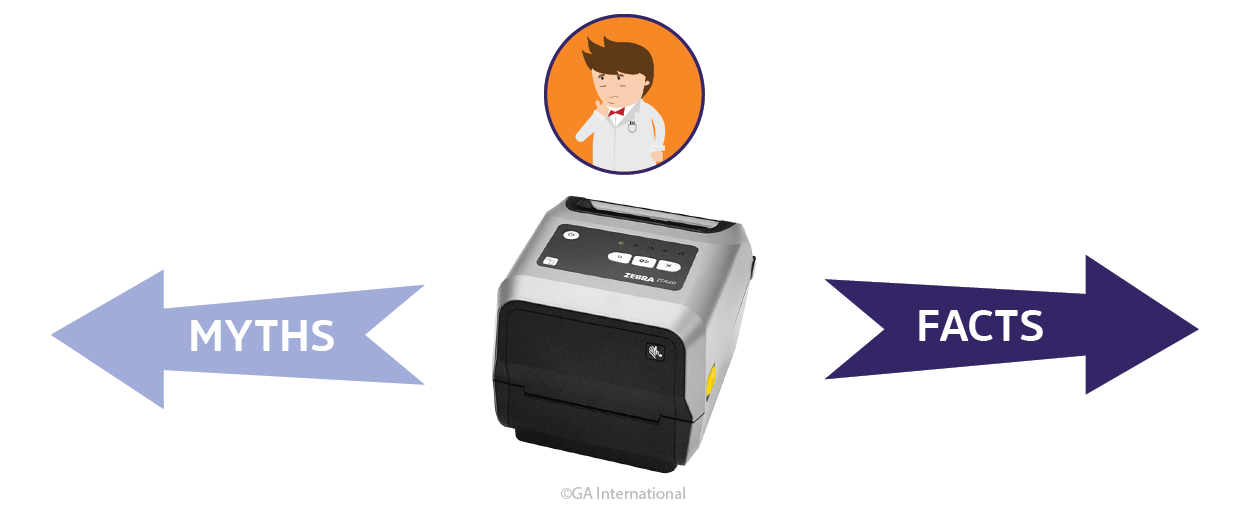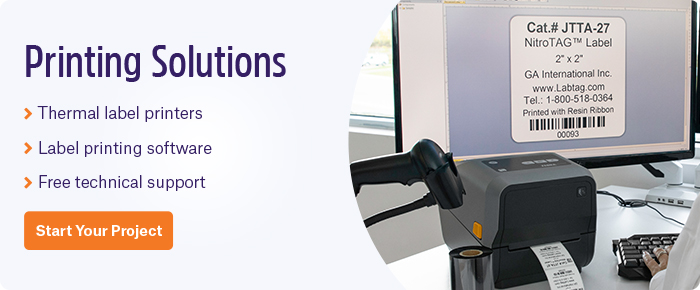 While thermal printing has been around for decades, there are still many myths surrounding thermal-transfer printing and labels. With so much riding on the proper identification of your samples, it’s important to get the facts straight when choosing your labels. Below, we’ve listed some of the most common misconceptions about thermal-transfer printing and addressed why these statements are inherently false.
While thermal printing has been around for decades, there are still many myths surrounding thermal-transfer printing and labels. With so much riding on the proper identification of your samples, it’s important to get the facts straight when choosing your labels. Below, we’ve listed some of the most common misconceptions about thermal-transfer printing and addressed why these statements are inherently false.
#1 – All thermal printers are the same
There are actually two types of thermal printers: direct thermal and thermal-transfer. While both use heat to generate a printout, they do it using vastly different methods. Direct thermal printers use paper that has been coated with a special leuco dye that changes color when heated. This means that direct thermal printers, unlike all other printers, don’t require any added ink source, making them a top choice by retailers for printing receipts. Thermal-transfer printers, however, print using an ink ribbon. The print-head will apply heat to the ribbon in order to transfer the ink from the ribbon to the facestock. The choice of thermal printing method will often rely on the application, with thermal-transfer labels offering greater resistance to chemicals and extreme temperatures.
#2 – Any kind of label material will do
It’s often assumed the resistance of thermal-transfer labels is independent of the label facestock. While thermal-transfer labels are usually made from thermoplastic film, paper labels can also be used with lab label printers, but this is usually not ideal. If you’re using thermal-transfer printouts, you probably need them for a reason, such as resistance to cryogenic storage or harsh solvents. Paper labels will absorb all liquid, from water to alcohol, causing them to shrivel up and fall off your containers.
#3 – They’re less eco-friendly
Thermal-transfer labels offer far superior customization than other printing methods, affording several eco-friendly options when using thermal-transfer printers. This includes solvent-free ribbons, which greatly reduce the carbon footprint per roll with zero impact on print quality, labels made of recycled materials, and fully compostable labels. In addition, thermal-transfer printers use small ribbons of ink and only print labels on rolls. This means you only print what you need, leaving you with a lot less waste overall.
#4 – All ribbons are the same
Ribbons for thermal-transfer printers can be made of either wax, resin, or a mix of the two. Resin ribbons will provide you with the greatest protection against extreme temperatures, chemicals, and abrasion compared with either wax alone or a mix of the two. Resin ribbons provide more value because of their improved printout quality.
#5 – Thermal-transfer labels will stick to anything
Not all products are created equal when it comes to thermal-transfer labels. A thermal-transfer printout will stay legible in many harsh environments, but the adhesive of the label will determine whether it remains affixed to the container. For example, only CryoSTUCK® labels can attach to surfaces that are already frozen, while chemical-resistant labels are produced using adhesives that are designed to resist harsh solvents, like xylene, toluene, and alcohols. All labels that come in roll format can be printed on using a thermal-transfer printer, though.
#6 – Thermal-transfer printers are relatively expensive
The price for a standard thermal-transfer printer can range from $450 to $3000, while a desktop laser printer can cost anywhere from $200 to $10,000. Moreover, because of the portability of thermal-transfer printers, the cost can be absorbed by more than one lab or department, as the printer can be carried or wheeled around between work stations much more easily than a laser printer. In addition, the unit cost per label is often lower than most other printers as the ribbon doesn’t need to be changed as often as ink cartridges or toners, and because you only print what you need without wasting labels.
#7 – It doesn’t matter where I get my labels from
Not all labels are made equal. A chemical-resistant label may withstand occasional contact with ethanol, other alcohols, and even xylene, but it may not be suitable for immersion/extensive exposure to these chemicals; a cryogenic label may be well-suited for -196°C storage but, depending on its size and nature of the container (type/shape of surface), it could fail in liquid nitrogen. Regardless of what you need the labels for, whether it’s resistance to xylene during histological analysis or to cryogenic temperatures for freezing patient specimens or primary cell lines, it’s always best to get your labels from a reputable manufacturer who will use only high-quality raw materials and provide reliable label printing services. They will also test them beforehand to ensure that they don’t fail and will often provide you a sample as well to ensure they are ideal for your unique conditions.
LabTAG by GA International is a leading manufacturer of high-performance specialty labels and a supplier of identification solutions used in research and medical labs as well as healthcare institutions.




